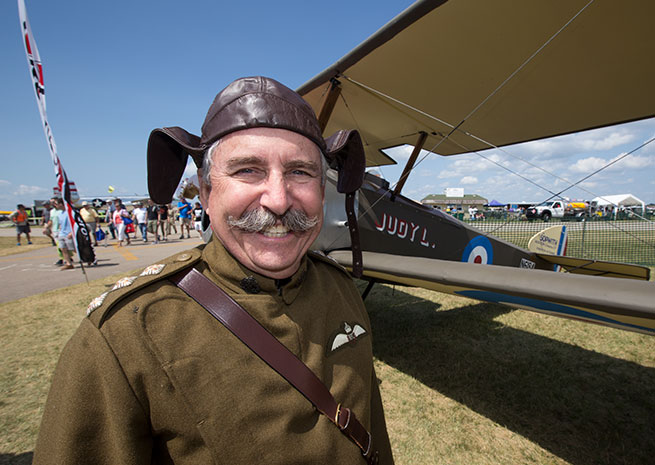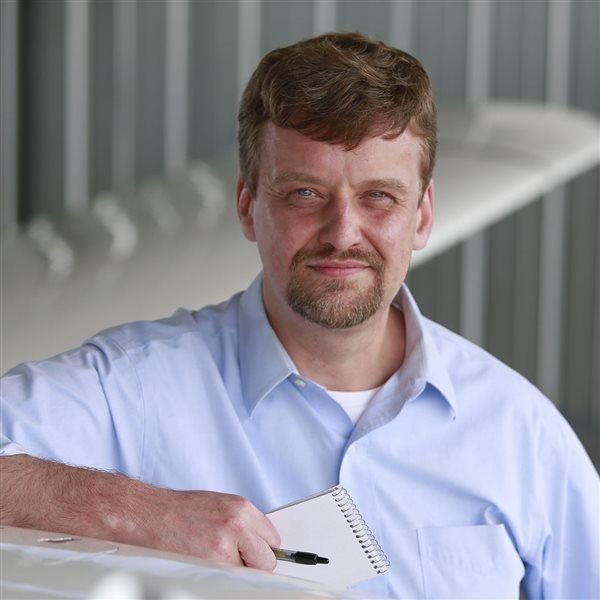
Glenn Burt has a grin on his face, ever happy to show off his Sopwith Pup, a vintage fighter newly built and based in Wausau, Wisconsin, and flown to Oshkosh for benefit of the curious, many of whom stopped by to pose for photos.
The commander of this (somewhat updated) 1916-edition fighter—a predecessor of very similar design to the Camel, which was the most maneuverable and deadly air weapon of World War I—said he got the job done for about $30,000. That, Burt said, includes the modern engine, hidden safely from view under a cowling. The machine gun does not fire, either (at least we’re pretty sure it doesn’t. Come to think of it, we didn’t ask). Other than that, it’s a full-scale copy of the original aircraft that earned a reputation as a much more docile cousin of the Camel.
Absence of the original rotary engine greatly tames handling characteristics that earned aircraft of this generation a reputation for being as dangerous to their pilots as the enemy. Bill Gordon, chief pilot at Old Rhinebeck Aerodrome, said in 2012 that he had logged three takeoffs and landings in the Camel, and “that was enough.” The gyroscopic force imposed by the spinning cylinders of a rotary engine allowed the original Camel to turn 270 degrees right in about the same time required for 90 degrees of (comparatively unstable) left turn, with strong tendencies to pitch the nose up or down somewhat steeply depending on the direction of turn.

Burt is not such a stickler for historic accuracy as to insist on a vintage rotary, though his replica Pup shares the same narrow wheelbase, and flight controls that can seem downright ineffectual if compared to modern aircraft. Burt acknowledged the aileron response may be a tad sluggish, but “isn’t as bad as a Stearman, where you have to make an appointment to turn.”
In fact, Burt insists, absence of a rotary engine makes the Pup downright docile.
"Ground loops can bite you,” though the Pup is generally “forgiving,” Burt said. “It’s a very gentle little airplane to fly.”
Burt spent much of the two-year build putting his cockpit together, finding some instruments online to extend the vintage look as far as possible. The interior is a snug fit, and Burt is happy to help the curious make the climb that rewards one with the perspective of a World War I flying ace, poised to launch from the aerodrome in France, in eternal pursuit of the Red Baron. Never mind the modern electrical switches and breakers on your right.
 The kit came from Robert Baslee, whose Holden, Missouri-based Airdrome Aeroplanes supplied replicas for the movie Flyboys, and continues to churn out an air power arsenal based on classic designs from both sides: Fokker, Nieuport, Bleriot, and others.
The kit came from Robert Baslee, whose Holden, Missouri-based Airdrome Aeroplanes supplied replicas for the movie Flyboys, and continues to churn out an air power arsenal based on classic designs from both sides: Fokker, Nieuport, Bleriot, and others.
Burt noted, with pride, that the Camel (the Pup's elder and very similar cousin) could turn easily inside its early-model Fokker competition.
Burt showed off the struts, metal covered in a wood veneer that, from nearly any distance, appear much like the original, though they do represent one more concession to modernity.
“I’m actually going to break down and make wood struts,” Burt said, his smile widening as the thought was amended: “No, I’m going to have a friend of mine make wood struts.”



